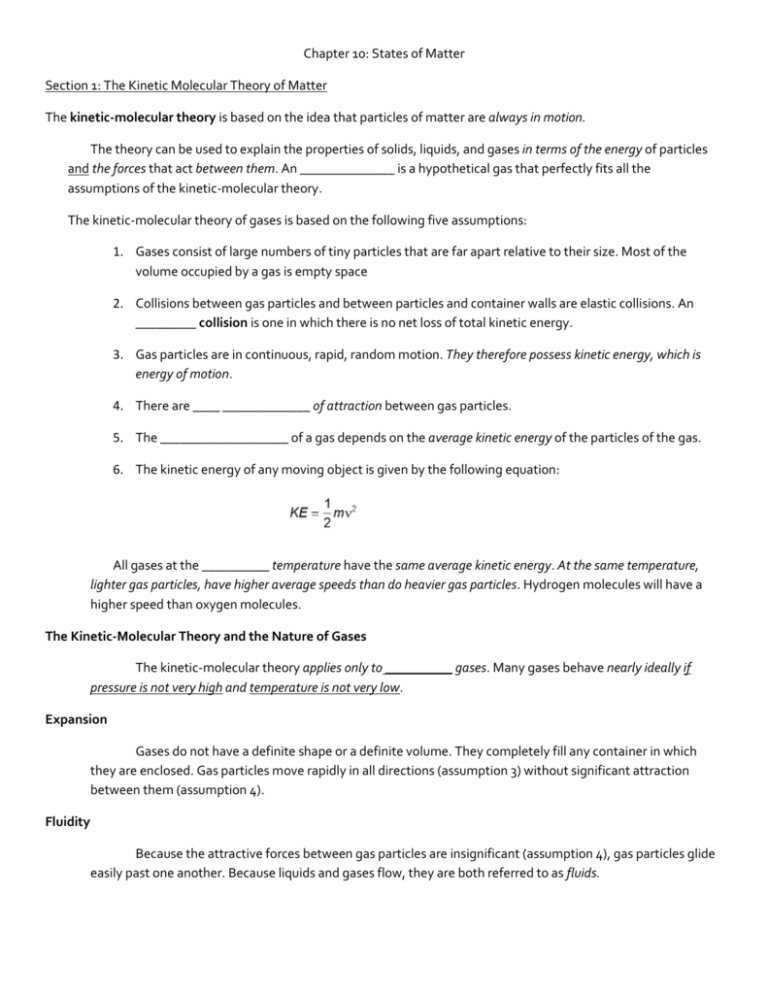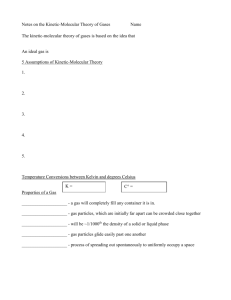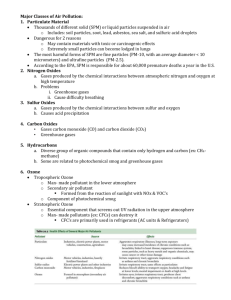Chapter 10: States of Matter Section 1: The Kinetic Molecular Theory
advertisement

Chapter 10: States of Matter Section 1: The Kinetic Molecular Theory of Matter The kinetic-molecular theory is based on the idea that particles of matter are always in motion. The theory can be used to explain the properties of solids, liquids, and gases in terms of the energy of particles and the forces that act between them. An ______________ is a hypothetical gas that perfectly fits all the assumptions of the kinetic-molecular theory. The kinetic-molecular theory of gases is based on the following five assumptions: 1. Gases consist of large numbers of tiny particles that are far apart relative to their size. Most of the volume occupied by a gas is empty space 2. Collisions between gas particles and between particles and container walls are elastic collisions. An _________ collision is one in which there is no net loss of total kinetic energy. 3. Gas particles are in continuous, rapid, random motion. They therefore possess kinetic energy, which is energy of motion. 4. There are ____ _____________ of attraction between gas particles. 5. The ___________________ of a gas depends on the average kinetic energy of the particles of the gas. 6. The kinetic energy of any moving object is given by the following equation: All gases at the __________ temperature have the same average kinetic energy. At the same temperature, lighter gas particles, have higher average speeds than do heavier gas particles. Hydrogen molecules will have a higher speed than oxygen molecules. The Kinetic-Molecular Theory and the Nature of Gases The kinetic-molecular theory applies only to __________ gases. Many gases behave nearly ideally if pressure is not very high and temperature is not very low. Expansion Gases do not have a definite shape or a definite volume. They completely fill any container in which they are enclosed. Gas particles move rapidly in all directions (assumption 3) without significant attraction between them (assumption 4). Fluidity Because the attractive forces between gas particles are insignificant (assumption 4), gas particles glide easily past one another. Because liquids and gases flow, they are both referred to as fluids. Low Density The density of a gaseous substance at atmospheric pressure is about 1/1000 the density of the same substance in the liquid or solid state. The reason is that the particles are so much farther apart in the gaseous state (assumption 1). Compressibility During compression, the gas particles, which are initially very far apart (assumption 1), are crowded closer together. Diffusion and Effusion Gases spread out and mix with one another, even without being stirred.The random and continuous motion of the gas molecules (assumption 3) carries them throughout the available space. Such spontaneous mixing of the particles of two substances caused by their random motion is called ___________________. ______________ is a process by which gas particles pass through a tiny opening. The rates of effusion of different gases are directly proportional to the velocities of their particles.Molecules of low mass effuse faster than molecules of high mass. Deviations of Real Gases from Ideal Behavior Because particles of gases occupy space and exert attractive forces on each other, all real gases deviate to some degree from ideal gas behavior. A _________ gas is a gas that does not behave completely according to the assumptions of the kinetic-molecular theory. At very high pressures and low temperatures, a gas is most likely to behave like a ________ - ___________ gas. The more __________ the molecules of a gas are, the more the gas will deviate from ideal gas behavior









